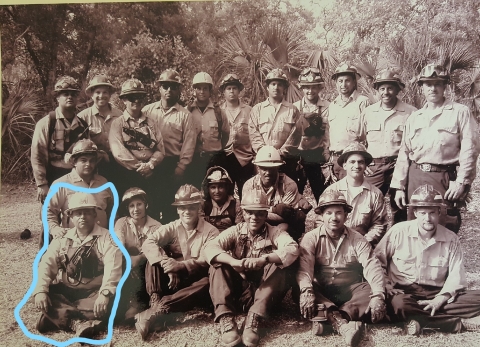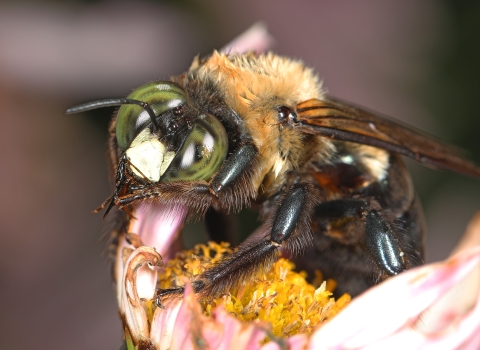Set against the backdrop of stunning sunsets and sandy beaches is a wildland firefighter training ground you may have never heard of – the fire program at Cabo Rojo National Wildlife Refuge in Puerto Rico. Cabo Rojo is one of nine national wildlife refuges we manage as the Caribbean Islands National Wildlife Refuge Complex. These refuges protect and restore tropical forests, neotropical migratory bird wintering grounds, and habitat for more than 78 threatened or endangered species. However, it’s not all sunsets and paradise on these islands: They are susceptible to wildfire, especially during the dry season or after hurricanes that leave down and dead vegetation that serves as available fuel for wildfires.
Although there are no fire-dependent ecosystems in the U.S. Caribbean, the introduction of non-native species has allowed fuels to build up, especially in areas of former sugarcane cultivation, which in turn makes the ecosystem susceptible to fire.
One way Cabo Rijo cuts hazardous fuels that can cause wildfires is issuing hay permits. These permits let local farmers gather feed for their animals, while reducing the wildfire threat to wildlife habitat and communities. James Padilla, who would become the fire operations specialist at Cabo Rojo, was issued a permit to bale hay on the refuge in 1998.
During this hay baling, the refuge manager, who had stopped by to check in on Padilla and his father, mentioned the refuge was struggling to contain the human-caused wildfires and needed to hire a wildland firefighter. But the refuge needed more than a firefighter. They wanted someone with knowledge of the terrain and relationships in the community. Padilla fit this bill. “I also spoke fluent English and Spanish, which is important for public relations here,” says Padilla, “so he hired me and sent me off to take the basic wildland firefighter training courses.” Now, 20 years later, Padilla and others have built a wildland fire training ground at Cabo Rojo, the first of its kind in the area.
Today, Padilla trains more than 100 structural firefighters , EMTs, natural resource professionals, and local volunteers each year to become certified wildland firefighters. Padilla administers annual fitness tests, heavy equipment training, chainsaw instruction, and first aid certification to prepare crews to respond to wildfires on the refuge and across the Caribbean Islands.
Many of the firefighters Padilla is helping to train come from agencies such as the Puerto Rico Fire Department (Bomberos Forestales) and the Puerto Rico Department of Natural Resources, and work with the U.S. Fish and Wildlife Service, U.S. Forest Service, National Park Service in an interagency effort to suppress severe fires that threaten communities and refuge habitat.
Padilla also prepares firefighters for deployment to the mainland United States, often to the western part of the country, to support peak wildfire season.
“It used to work well, as soon as Puerto Rico’s wildfire season was wrapping up, fire season in the western U.S. was just beginning. It was good timing. Now with climate change climate change
Climate change includes both global warming driven by human-induced emissions of greenhouse gases and the resulting large-scale shifts in weather patterns. Though there have been previous periods of climatic change, since the mid-20th century humans have had an unprecedented impact on Earth's climate system and caused change on a global scale.
Learn more about climate change , the seasons are beginning to overlap,” says Padilla. After battling their own blazes at home, Padilla’s crews are deployed where resources are needed on the mainland. Padilla focuses on training to the highest skill level he can on island, then sends newly trained firefighters to fires in the western U.S. to gain wildfire suppression experience in differing fuel types and terrain.
On average, the Caribbean Complex deploys five Type 2 Initial Attack (Type 2 IA) crews per year. Type 2 IA crews are highly trained, 100% self-sufficient, and aggressively attack new fires as the first on-scene firefighters. Altogether, the complex supplies personnel resources to approximately 22 fires per year.
Typically, as the fire season begins to slow, hurricane season is ramping up. The Caribbean fire crews are prepared for this transition, as the skills gained from firefighter training are transferable to other kinds of natural disasters. The program Padilla instructs also provides all-hazard training for Federal Emergency Management Agency (FEMA) employees, training them in the same chainsaw skills firefighters learn. Following a storm, firefighters can respond with heavy equipment like bulldozers and chainsaws to assist in clearing roads to make way for utility companies to do necessary infrastructure repairs.
When Padilla first started fighting fire in 1998, he was a seasonal wildland firefighter and the sole U.S. Fish and Wildlife Service fire employee in Puerto Rico. Today, he supervises two full-time fire employees, one stationed at Cabo Rojo and one at Vieques National Wildlife Refuge (Puerto Rico). Together, they train and oversee 109 emergency hire (administratively determined) firefighters that supplement their ability to fight seasonal wildfires at the complex.
“Fighting fire on an island has its unique challenges," Padilla says. "It’s not like we can easily call on a neighboring state for supplemental firefighters or equipment. Any additional resources are going to take a long time to reach us if we need them. So, we must have everything here and available, have everyone prepared and trained to not only fight fire but provide other emergency services too. That’s why these trainings are so important.”
A prescribed burn is the controlled use of fire to restore wildlife habitat, reduce wildfire risk, or achieve other habitat management goals. We have been using prescribed burn techniques to improve species habitat since the 1930s.
Learn more about prescribed burn at Florida Panther National Wildlife Refuge. Photo by Josh O’Connor/USFWS
During #CaribbeanAmericanHeritageMonth, we thank the Caribbean National Wildlife Refuge Complex and their dedication to #PrepareForWildfires. A very special thanks goes out to the firefighters from Puerto Rico, who leave their day jobs and travel far from home to serve as wildland firefighters in a time of need. #WeAreUSFWS







